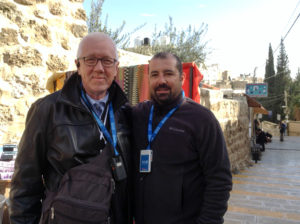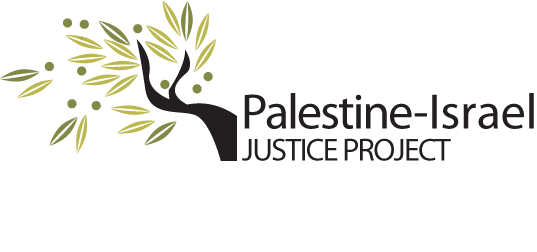Palestine/Israel: Advocating for a Just and Lasting Peace with Equal Rights for Palestinians in Accordance with International Law and Wesleyan Tradition
This curriculum was written by the Palestine/Israel Justice Project in response to 2009 Minnesota Annual Conference Resolution #508 that states “The Minnesota Annual Conference will formulate its case for a just and lasting peace with equal rights for Palestinians in the Middle East in keeping with international law and Wesleyan tradition. The curriculum will be distributed to each Episcopal area…”
How to Use this Curriculum
 There are 9 Sessions, each 55 minutes in length. These sessions can be used for a Sunday school study, Adult Forum, or weekday evening studies.Ideas for extending the curriculum are given in some lessons. Discussion times can also be lengthened if your time frame allows. Additional resources are listed in the Appendix at the end of the curriculum.
There are 9 Sessions, each 55 minutes in length. These sessions can be used for a Sunday school study, Adult Forum, or weekday evening studies.Ideas for extending the curriculum are given in some lessons. Discussion times can also be lengthened if your time frame allows. Additional resources are listed in the Appendix at the end of the curriculum.
Your classes can be in person or on line via Zoom.
For in person classes:
This is a web-based curriculum, which means that much of the information is in the form of links to websites. For this reason, you will need access to a computer, perhaps laptop, and means to project the images onto a screen or TV monitor. You should be able to access the links by simply clicking on the address in the curriculum if you are connected to the internet. If this doesn’t happen, you can highlight and copy the address and then paste it to access the website.
When printing materials, please go to the end of the section and click on printer-friendly version.
Several documents are to be used throughout the sessions. The Kairos document is one of these and you will want to have a copy available for each participant the first session, stressing that these should be saved and used often throughout the course of study. Here is a link to the Kairos document.
Occupation 101 is a DVD that can be purchased from various internet websites or downloaded from Google Videos (see Session 4). It is also embedded in the curriculum under Reference Material. If you do not have internet access where you are teaching the class you can download the video to your desktop to show it. This can also be done with the video clips used in sessions 6 and 7.
Also, throughout the curriculum, the instructor will strive to tie scripture, the social principles, and international law together in assessing the history of the Palestinian-Israeli conflict and what can be done to bring about a just solution. The sheets made during the 2nd Session should be posted and added to in subsequent sessions.
You may wish to provide each participant with a 3-ring folder or binder in which to keep class materials. Each session’s materials can be printed on a different color paper and whole punched in advance.
If you run out of time with any of the sessions, you may wish to have the participants read the remaining materials and reflect on them at home.
It is helpful after Session 2 to type up the summaries and pass them out to the class for use in Session 3.
Be aware: There is quite a bit of prep work for Session 7 with the printing of all the readings.When you access the link, you may wish to copy and past the information from the website into a document. The print is larger and easier to read and a lot of the extras on the website are eliminated. Add the following before copying–Source: Amnesty International for the reading for Session 6, Source:The Israeli Committee Against House Demolitions for the first reading in Session 7 and Source: B’Tselem for the rest of the readings.
For on-line sessions:
This is a web-based curriculum, which means that much of the information is in the form of links to websites. This makes it easy to teach the lessons on-line. Before teaching, make tabs of each website you will be sharing. You should be able to access the links by simply clicking on the address in the curriculum if you are connected. Also, make sure you have permission to use and know how to use the “share screen” function of Zoom.
You may want to send out the links to documents and videos ahead of time so participants can read or view the material ahead of time. For instance, the Kairos document is fairly long
and it would be beneficial to provide this prior to Session 1. This can be included in your “welcome to our class email” prior to Session 1 and in a recap email of the prior session
sent between sessions.
Occupation 101 is a DVD that can be purchased from various internet websites or downloaded from Google Videos (see Session 4). It is also embedded in the curriculum under
Reference Material. You can download the video to your desktop to show it. This can also be done with the video clips used in sessions 6 and 7.
Also, throughout the curriculum, the instructor will strive to tie scripture, the social principles, and international law together in assessing the history of the Palestinian-Israeli conflict and
what can be done to bring about a just solution. Jamboard provides a digital whiteboard that you can save and add to in subsequent sessions. Find it at https://jamboard.google.com.
There are also tutorials to help you learn how to use it on YouTube.
If you run out of time with any of the sessions, you may wish to have the participants read the remaining materials and reflect on them at home.It is highly suggested that you do a practice run with sharing screen for videos and printed material as well as Jamboard with friends as your “students” prior to actually teaching the sessions.
<< Introduction | How to use the Curriculum (current) | Reference Materials >>
